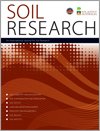Soil Research
Volume 59
Number 6 2021
Special Issue
Soil Organic Matter in a Stressed World
Guest Editors
Mark Farrell (CSIRO)
Lynne Macdonald (CSIRO)
Asmeret Asefaw Berhe (UC Merced, USA)
Alan Richardson (CSIRO)
Brian Wilson (UNE)
Tim Cavagnaro (University of Adelaide)
Mike Beare (Plant and Food Research, New Zealand)
Helen Glanville (Keele University, UK)
Māori, and many traditional peoples, regard the whole landscape as essentially interdependent and consider that the wellness of any part of it, be it soils, vegetation, water quality, etc., can only be understood within the context of the whole network of connections that sustain life. The challenge for researchers, from an indigenous perspective, is to be mindful of the ‘whole’ while focusing on the areas of their particular expertise.
A significant body of research on soil organic matter has been carried out in Scotland during the last decade. This review highlights major findings and identifies the need for more work addressing the urgency of the climate emergency and its impact on soil organic matter. Significant changes to land and soil management need to be implemented, in legislation and in practice, with existing mechanisms for informing policy development providing a possible way of achieving these changes.
Healthy and productive soils are essential to life on earth, supporting the growth of food and fibre. A largely ignored aspect in agricultural soil research is the contribution of subsoil microorganisms to biological activity and biomass, with both being important in the health and productivity of soil. Our research indicates that subsoil microbial activity contributes significantly to the overall microbial activity down the soil profile and could therefore make a significant contribution to the sustainable management of Australian cotton systems.
Soil organic carbon can be both a source and sink of atmospheric carbon dioxide, with important implications for climate change. Responses of soil organic carbon under grazed pastures to irrigation vary from increases, no difference, to reductions when compared with unirrigated pasture. Over an annual pasture production cycle, irrigation did not affect soil organic carbon storage. However, summer irrigation promoted the transfer and storage of photosynthate-derived carbon in the fine particulate organic matter and clay size fractions.
Current agricultural management systems should integrate sustainable technologies to be more efficient, as well as decreasing adverse environmental impacts. One of the key elements in agroecosystems is status of the soil, which strongly depends on agricultural systems, crop rotations, organic and the use of mineral fertilisers. Experiments from long-term organic farming systems during four crop rotations, including different catch crops used as green manure, especially in combination with farmyard manure revealed positive effects on soil humus.
Sheep grazing is a common practice to control weeds, but little is known about its effect on soil health. Sheep grazing enhanced soil organic carbon but not nitrogen compared to tillage and herbicide application. Producers can improve soil organic matter and health by using sheep grazing on weeds and crop residue in dryland cropping systems.
Woody plant encroachment has transformed land-cover patterns in savannas and grasslands throughout the world, with implications for changes in soil organic carbon dynamics. In a study of pairs of neighbouring, woody encroached and grassland plots along a gradient from 300 to 1500 mm average annual rainfall, we examined three soil fractions down to a depth of 1 m. We found that shrub-encroached grasslands potentially sequester more carbon in soils of arid regions than in humid regions.
The impacts of Acacia pendula and Eucalyptus camaldulensis used in environmental plantings on soil properties and microbial activity were tested. Changes in soil properties (total organic carbon, total nitrogen and extractable phosphorus) and microbial activity were elevated under the canopy, but the effect diminished with soil depth. The A. pendula made a greater contribution toward enhancement of soil nutrients and microbial activity than E. camaldulensis.
Blue carbon environments have the potential to assist in climate change mitigation by storing significant amounts of carbon in their above- and below-ground biomass and soils. The role of mangrove and tidal marsh vegetation on the carbon and nitrogen contents of temperate wetland surface soils and the spatial variability of stocks across and within vegetation type are quantified. Carbon and nitrogen stocks are driven by the geomorphology, environmental conditions and organic matter supply within sites rather than vegetation type.
Organic amendments have a range of chemical compositions that affect their stability upon application to soils. We used a range of spectroscopic techniques coupled with chemometric analysis to predict their decomposability. We found that all tested spectroscopic techniques had strong predictive capacity to explain partitioning of organic amendment decomposition into fast and slow pools, but not their decomposition rates. Importantly, partitioning was strongly related to chemical composition, particularly carbohydrate, protein, and lignin signals.
Fatty acid-based lipids comprise a small but vitally important component of soil organic matter. The aim of this study was to use altitudinal transects to explore the factors controlling composition of intact fatty acid-based lipids. There were large differences among sites in the relative amounts of lipid classes and their fatty acid inventories, lipid composition among sites was most strongly most strongly associated with pH.





